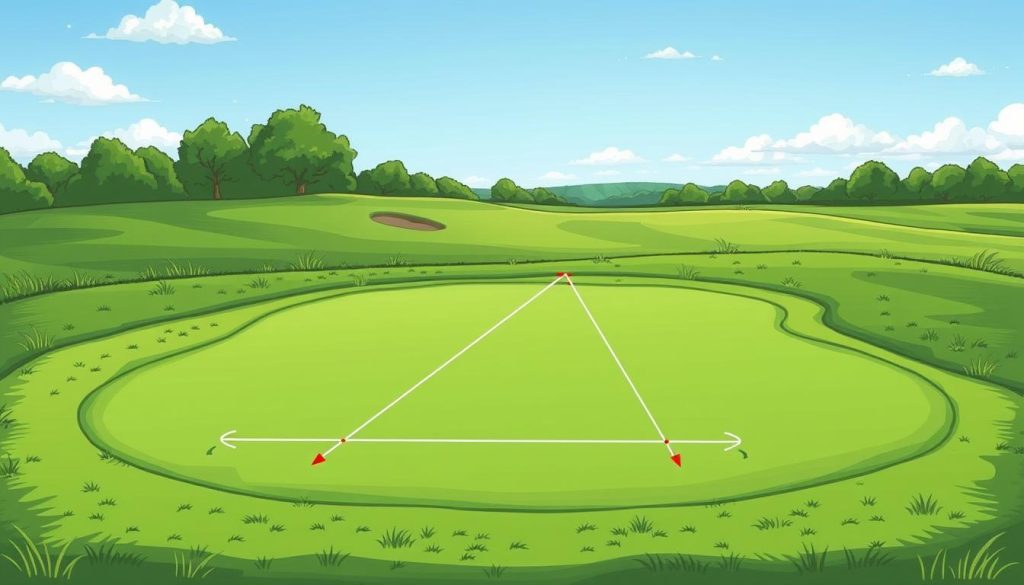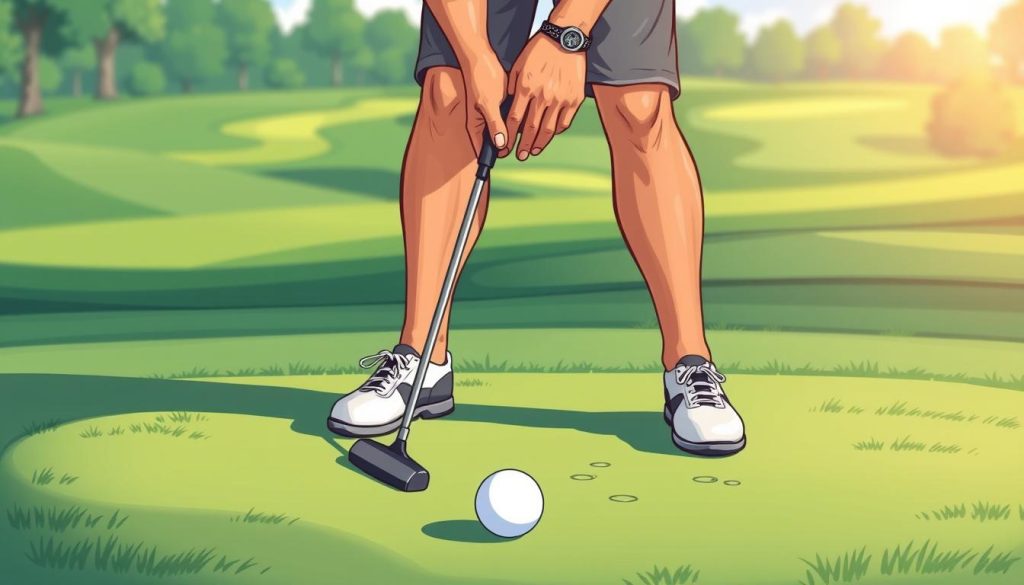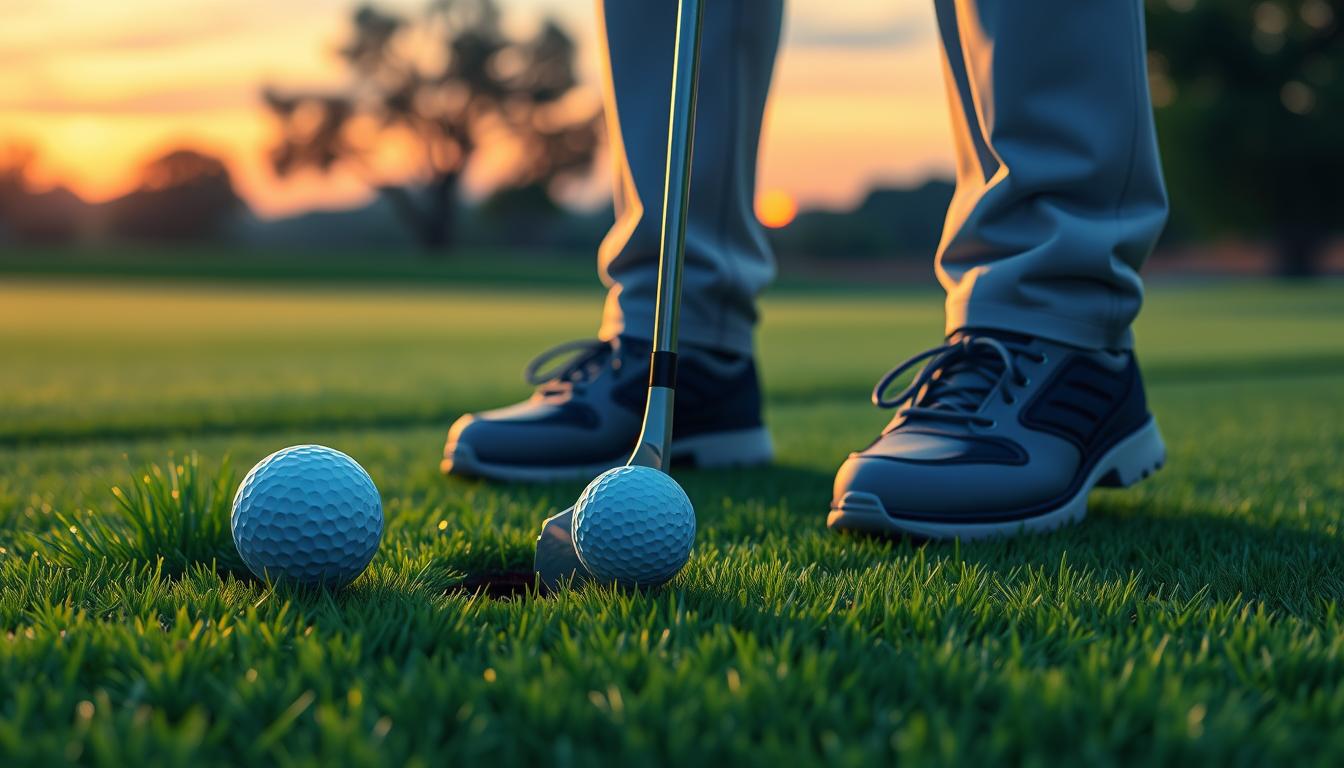Golf putting techniques can greatly impact your game. This guide will help you improve your stroke and increase your putting accuracy. You’ll learn how to read greens and control your speed better.
Did you know PGA Tour players only make 50% of their putts from 8 feet? For casual golfers, the best chance to hole out is within 10 feet. Beyond that, your success rate drops fast. That’s why learning effective putting stroke strategies is key to lowering your scores.
Speed control is essential for good putting. It helps with both short and long putts, leading to more made shots and better long putt outcomes. To get better, focus on smart practice and play more games. Tools like Blast Motion and TIBA Putt can help with speed control.
Top putters have one thing in common: they consistently start the ball on the right line. This skill, combined with good green reading, is crucial for making more putts. Learning the AimPoint Express system can improve your slope-reading skills.
Key Takeaways
- PGA Tour pros make only 50% of 8-foot putts
- Speed control is crucial for all putt lengths
- Starting the ball on line is a key skill for success
- Green reading significantly impacts putting accuracy
- AimPoint Express can improve slope-reading skills
- Smart practice and more play time enhance putting
Understanding the Fundamentals of Golf Putting
Golf putting is all about precision and patience. It mixes technical skill, spatial awareness, and mental focus. To get better, you need to understand the science of a perfect putt, what makes a good putt, and how green speed and slope affect it.
The Science Behind a Perfect Putt
Putting mechanics are about finding the right balance of force and direction. When you hit the ball, it should roll smoothly towards the hole. The motion of the golf ball on the green depends on speed, spin, and the green’s texture. A good putt rolls smoothly without skidding.
Key Components of Putting Success
Success in putting comes from several key areas:
- Proper stance and alignment
- Consistent stroke
- Accurate green reading
- Distance control
- Mental focus
Keeping a steady posture and avoiding wrist movement are crucial for accuracy. Hitting the ball with the putter’s sweet spot helps it roll smoothly.
The Role of Green Speed and Slope
Understanding the green is key to good putting. The green’s speed and slope greatly affect the ball’s path. Skilled players use different methods to read greens, like visual inspection and the AimPoint technique. Knowing where the ball will break on sloped surfaces is essential.
| Green Reading Method | Description | Difficulty Level |
|---|---|---|
| Visual Inspection | Observing contours and grain direction | Easy |
| Plumb Bob | Using gravity to gauge slope | Moderate |
| AimPoint | Scientific approach to slope calculation | Advanced |
By mastering these basics, you’ll improve your putting and lower your scores.
Essential Setup and Positioning Techniques
Mastering putting starts with a solid setup and positioning. A study at Bayonne GC looked at 90 golfers. It found that setup often gets worse as players move up tee boxes. Let’s look at the key elements to improve your putting.
Proper Stance and Alignment
Your putting stance is key for consistency. Stand with feet shoulder-width apart for balance. Make sure your body is parallel to the target line.
A wider stance can affect your swing arc. A narrower stance may help with rotation but could make your swing unstable.
| Stance Width | Pros | Cons |
|---|---|---|
| Wide | Stable base | Can lead to fat/thin shots |
| Narrow | Enhances rotation | Potential instability |
Eye Position Over the Ball
Eye alignment is crucial for accurate putting. Place your eyes directly over or slightly inside the ball. This view helps you see the line clearly.
Use a mirror during practice to check your eye position. Make sure your body lines are parallel to the target.
Grip Pressure and Hand Placement
Your putter grip affects your entire stroke. Hold the club with a comfortable yet firm grip. For right-handed golfers, the V’s formed by thumb and forefinger should point to the right shoulder.
A bad grip angle can cause problems. It can lead to issues like excessive shaft lean or increased shoulder tilt.
Remember, a proper setup is the foundation of a great putt. Practice these techniques regularly to improve your consistency on the green.
Putting Stroke Strategies Guide
Mastering putting stroke mechanics is key to achieving putting consistency on the green. A successful putting stroke relies heavily on face angle control at impact. Despite common belief, all putting strokes have some arc, rather than following a straight back and straight through path.
The direction of your putter face at impact largely determines where your ball will go. To improve your stroke, focus on squaring the putter face to your target at impact. This technique has proven successful for many golf pros, including Dave Stockton, who once went 950 holes without a three-putt.
Stockton emphasizes the importance of a 4-degree static loft on a putter for most players. He suggests dividing your putt into three equal parts, giving more weight to the final third. For alignment, pick a spot close to the ball on your target line.
| Aspect | Stockton’s Advice |
|---|---|
| Practice Swings | Avoid overthinking, maintain flow |
| Putting Approach | Focus on feel and roll, not hitting |
| Mindset | Visualize success, stay confident |
To enhance your putting consistency, practice regularly with specialized putting balls. These provide instant feedback on your stroke mechanics. Remember, mental preparation is crucial. Establish a routine, visualize success, and maintain focus to improve your performance on the greens.
Mastering Green Reading Fundamentals
Green reading is key for golfers wanting to better their putting. It can lower your scores and make you more confident on the greens. Let’s look at some important methods and techniques for analyzing green slopes and predicting breaks.
Visual Assessment Methods
First, observe the green’s contours from various angles. Think about how water would flow if poured on it. This simple trick can reveal subtle slopes and breaks you might miss otherwise.

Understanding Break Points
Every putt has a high point where it starts to curve toward the hole. Finding this point is key for aiming right. Faster putts break less, while slower ones break more. Practice seeing the ball’s path before you putt to get better.
Using the AimPoint Technique
AimPoint Express is a favorite among pros. It measures slope with your feet, not just by looking. Feeling the slope helps you guess the putt’s direction and break more accurately.
| Factor | Impact on Green Reading |
|---|---|
| Grass Grain Direction | Affects ball speed: slower into the grain, faster with the grain |
| Environmental Factors | Sun position and shadows can exaggerate perceived breaks |
| Green Speed | Faster greens generally result in more break |
| Moisture Content | Wet greens slow putts and reduce break |
By using these green reading basics, you’ll get better at tackling tough greens. Remember, the more you practice, the more confident you’ll become in your putting.
Speed Control and Distance Management
Mastering putt distance control is key to lowering your golf scores. It makes the hole seem bigger, especially for short and long putts. But, hitting putts harder doesn’t help you sink them more often.
Knowing the green’s speed is crucial for better putting. Each green is different, and understanding these differences can boost your success. Try practicing on various greens to get better at judging speed and slope.
Lag putting is vital for handling longer putts. It’s about getting the ball close to the hole without going over. To get better at lag putting:
- Practice with different distances on the putting green
- Keep your backstroke length consistent
- Use tools like tees or alignment sticks for help
- Do drills that focus on speed control
Tools like Blast Motion and TIBA Putt can improve your stroke timing and face strike. Regular use of these tools can greatly enhance your putting skills.
| Distance (feet) | Make Percentage | Focus Area |
|---|---|---|
| 0-3 | 99% | Confidence |
| 4-6 | 75% | Accuracy |
| 7-10 | 50% | Speed Control |
| 11-20 | 20% | Lag Putting |
| 21+ | 10% | Green Reading |
Improving speed control takes a lot of practice and experience. By focusing on these areas, you’ll see your putting skills improve a lot.
Advanced Stroke Mechanics and Rhythm
Improving your golf game starts with mastering advanced putting techniques. Focus on stroke rhythm, impact consistency, and follow-through. You’ll notice a big difference in your putting skills.
Pendulum Motion Basics
A smooth putting stroke is like a pendulum. Keep your hands and wrists still. Let your shoulders move the putter. This makes your stroke rhythm consistent, key for accurate putts.
Face Control Through Impact
Proper face control is crucial for consistent impact. Keep your eyes on the ball all the way through. This ensures you hit the ball right, improving its roll and direction.

Follow-through Techniques
Follow-through is vital in putting. It keeps your stroke rhythm smooth and boosts accuracy. Practice extending your stroke after hitting the ball. Keep the putter face straight to your target.
Improving these advanced mechanics takes time and effort. Set up a practice area at home with a putting mat. Use video to check your technique and see how you’re doing. With hard work, you’ll get better at putting.
Practice Drills and Training Methods
Improving your golf game starts with good putting practice routines. By using different drills, you can better your putting stroke. This will help you perform better on the green.
Gate Drill Variations
The putting gate drill is a favorite among golfers. It involves setting up two tees wider than your putter head. Then, you practice hitting putts through this “gate.”
This drill helps keep your putter face square. It also teaches you a short, controlled stroke. These skills are key for making those tough short putts.
Clock Face Exercise
The clock face drill is great for practicing putts from different angles. Place balls around the hole like numbers on a clock. This drill helps you get better at breaking putts.
It also improves your green reading skills. You’ll learn to read greens from various spots.
Distance Control Games
Mastering distance control is crucial for putting. The ladder drill is a good way to practice this. Start with three balls at 3, 6, and 9 feet from the hole.
Putt each ball, aiming to make three consecutive putts. Then, move to the next distance. This drill helps you feel different distances.
| Drill | Focus Area | Benefit |
|---|---|---|
| Gate Drill | Accuracy | Improves putter face alignment |
| Clock Face | Green Reading | Enhances ability to read breaks |
| Ladder Drill | Distance Control | Develops feel for various lengths |
Consistency is key to improving your putting. Spend regular time on these drills. Focus on quality, not quantity. With regular practice, you’ll see your putting skills improve.
Equipment Selection and Optimization
Choosing the right putter is key to a good putting game. There are mainly two types: blade and mallet. Blade putters are loved by those who value feel, offering a classic look. Mallet putters, on the other hand, are great for forgiveness on off-center hits.
When picking your putter, think about length, weight, and balance point. These factors are important for your putting performance.
Customizing your equipment is also crucial. Adjusting loft and lie angle can greatly affect your stroke. Many golfers find success with putters from Scotty Cameron, Odyssey, TaylorMade, and Ping.
Using putting aids can make your practice better. Indoor putting greens let you train consistently, no matter the weather. Here’s a look at some popular putting aids:
| Putting Aid | Purpose | Benefit |
|---|---|---|
| Alignment Sticks | Improve aim and stroke path | Enhances consistency |
| Putting Mirror | Check eye position and alignment | Develops proper setup |
| Putting Gate | Practice accuracy | Improves precision |
| Putting Mat | Indoor practice | Allows year-round training |
The best equipment is what feels right for you. Take time to try out different putters and aids. With the right tools and practice, you’ll see your putting game improve.
Conclusion
Improving your putting stroke is key to lowering your golf score. This guide gives you a detailed plan to boost your putting skills. It shows how practice is crucial for better performance on the green.
By working on consistency, accuracy, and confidence, you can see big score drops. This will also make playing golf more fun for you.
Just like pros, spend most of your practice time on short putts. Aim for 90% of your practice to be within 10 feet of the hole. This will help you avoid costly three-putts and improve your short game.
Try different putting techniques and putters to find what suits you best. The GP putter is a good option to consider.
Drills like the Gate Drill, Distance Control Drill, and Clock Drill are great for a consistent stroke. Use tools like flat putting mats and golf putting drill PDFs to improve your practice. Regular, focused practice is better than long, infrequent sessions.
By following these tips and staying committed, you’ll become a more confident and successful putter.
FAQ
What is the most important factor in improving my putting stroke?
How can I improve my green reading skills?
What’s the best way to practice putting?
How important is speed control in putting?
What should I consider when choosing a putter?
Is there a straight back and straight through putting stroke?
How can I improve my putting accuracy?
What percentage of putts do PGA Tour players make from 8 feet?
Can using an indoor putting green improve my skills?
What is the AimPoint Express system?
Source Links
- https://practical-golf.com/putting-tips
- https://pyramidgolf.com/blogs/news/top-10-putting-stroke-tips-for-a-smooth-steady-roll
- https://puttingworld.com/putt-for-par/
- https://skillest.com/blog/master-the-art-of-golf-putting-a-comprehensive-guide-for-beginners/
- https://www.golfzongolf.com/blog/technology/the-art-of-putting-in-golf-a-comprehensive-guide
- https://www.scienceandmotion.com/download/docs/fundamentals/The Fundamentals of Putting1.pdf
- https://golf.com/instruction/perfect-golf-swing-balanced-setup/
- https://www.hopkinsmedicine.org/health/conditions-and-diseases/stroke/arm-care-after-a-stroke
- https://alamocitygolftrail.com/dave-stocktons-all-time-top-ten-putting-tips/
- https://twoputtpro.com/blogs/putting-ball-and-drills/better-putting?srsltid=AfmBOoqdaKeY4cgPIANMQDdA2L9_wmTX47T3BryJG57Gq11Lwu9dI6J8
- https://www.golfzonleadbetter.com/blogs/putting-tips-how-to-read-a-green/
- https://patch.com/pennsylvania/doylestown/mastering-art-putting-guide-lower-scores
- https://www.riverhillscountryclub.com/membership/how-to-read-greens-and-improve-putting-an-ultimate-guide-67c97.html?LayoutID=6
- https://back2basics.golf/blogs/news/distance-control-and-backstroke?srsltid=AfmBOorz_0jOpnGbcYzB21KA1Iljfh_BNsFwaRYWC_gd7wbSthPTQMW9
- https://hackmotion.com/best-putting-tips/
- https://practical-golf.com/putting-distance-control
- https://www.golftrainingaids.com/blogs/articles/how-to-putt-better?srsltid=AfmBOopXgPPP2aEMiLh9AiW9gALWgkEHftqONXWPcXZt0x2wT7OLm85l
- https://gy.net.au/articles/viewArticle/elevate-your-game-advanced-putting-strategies
- https://www.riverhillscountryclub.com/membership/how-to-practice-golf-at-home-without-a-course-a-complete-guide-65c97.html?LayoutID=6
- https://golf.com/instruction/putting/putting-exercises-at-home-adam-smith/
- https://twoputtpro.com/blogs/putting-ball-and-drills/better-putting-stroke?srsltid=AfmBOooTSBhCfk-UFmacf_yY_x7LDTzIil8tMwnn3CAS_YgPKj8zUaX0
- https://pmc.ncbi.nlm.nih.gov/articles/PMC3196659/
- https://hackmotion.com/how-to-prepare-for-golf-tournament/
- https://pmc.ncbi.nlm.nih.gov/articles/PMC4647149/
- https://twoputtpro.com/blogs/putting-ball-and-drills/better-putting-stroke?srsltid=AfmBOorXKj25es6f6_0bdDtesprL0evwr9SDx_BpDZr1z7EcO0y_iFQg
- https://www.dgputtheads.com/disc-golf-putting-tips
- https://www.cascade.app/blog/guide-to-strategy-implementation


